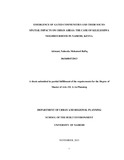| dc.description.abstract | Gated communities are relatively new phenomena that have become very popular
globally and in Kenya. Gated communities have been observed not only in the
USA but also in other parts of the world such as Lebanon, South Africa, Saudi
Arabia, and Latin America (Webster, Glasze, & Frantze, 2002). They are
security developments with designated perimeters, usually walls or fences, and
controlled entrances that are intended to prevent entry by non-residents. They
include new developments and older areas retrofitted with gates and fences, and
they are found from the inner cities to the exurbs and from the richest
neighbourhoods to the poorest (Blakely & Snyder, 1997a). These new residential
areas occur in both new suburban developments and older inner city areas for the
purposes of security and segregation.
This thesis considers the emergence of gated communities in urban areas and
discusses the reasons for their increasing numbers and popularity. Focusing on
Nairobi city and in particular Kileleshwa neighborhood, the study was undertaken
to determine the reasons for residents moving into gated communities and to
examine the impact of spatial and social fragmentation of the same on future of
urban planning and development. The study objectives were: to establish the main
reasons for people moving into gated communities: to establish the extent to
which gated communities contribute to a sense of community: to establish the
extent to which gated communities contribute to spatial fragmentation of urban
areas and implication of gated community development on planning of urban
areas in future: and finally to establish interventions which can be adopted to
reduce spatial and social fragmentation of the urban areas.
Qualitative and quantitative data collection and analysis methods were employed.
Sources of primary data included personal observation, household surveys for the
residents of gated communities and key informant interviews. Secondary data
sources included journals, research materials, text books, previous studies on
gated communities as well as internet sources. A sample of 60 households was
selected using simple random sampling method and the data from the
questionnaires was analyzed using statistical data analysis software, SPSS and
consequently conclusions and recommendations were derived based on the
findings.
It has been found that the reasons why people moved into gated communities are
for safety and security, proximity to facilities and services, proximity to their
place of work as well as the availability of facilities and services within the gated
communities. The study findings will help in understanding the diverse
experiences of residents and their motivations for moving to gated communities
and how the same would impact the urban areas.
The study recommends that the Nairobi County Government should come up with
planning policies that cater for and include gated communities so as to regulate
their development in order to minimize their negative impacts on our urban areas. | en_US |



